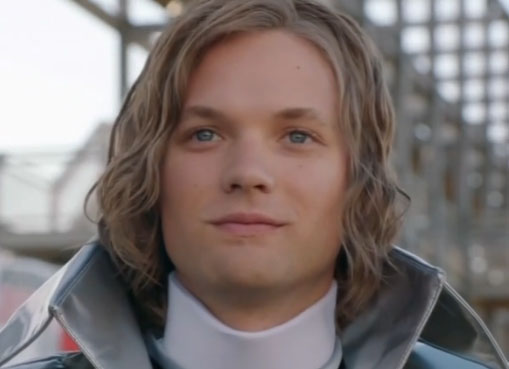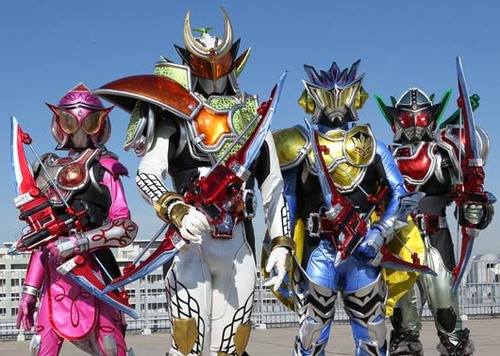The evil Queen Ahames, played by Fukumi Kuroda
The real Fukumi Kuroda (center) in April 2013, as she receives a plaque of appointment as a tourism ambassador of Gyeonggi province in South Korea, with Gyeonggi governor Kim Moon-soo (right) and Gyeonggi Tourism Organization chief executive Hwang Joon-kee.
1) Changeman : a sentai series about war which goes beyond good vs evil.
Dengeki Sentai Changeman is the ninth series in the Super Sentai franchise, and shows the fight of the Changeman and their allies from the Earth Defense Force against the evil Gozma, aliens who want to conquer Earth. However, Hirohisa Soda wisely avoided a simplistic plot with Humans = Good, Aliens= Evil. In several episodes, Changeman show aliens who are shown not to be evil (notably, in episodes 11, 16, 23, 26, 45), with a best example being the Rigelian Nana, who became a recurring character as an ally of the Changeman. More importantly, most of the Gozma themselves were in fact shown to be forced to fight for Star King Bazoo. Some Monsters of the week were shown to be either victims of Bazoo, often forced to fight the Changeman for him (like Taro in episode 7, the tragic case of Prince Icaros in episode 41, and even the sadistic Pain in episode 28). More importantly, even most of the main generals of Gozma were in fact shown to be coerced into fighting for Bazoo with the hope that they will be rewarded with their own planet's restoration, like Shima, Giluke and Ahames. While they were cruel, they fought for the same reason the Changeman were fighting : to protect their home planet. Gator was working with Bazoo because he was very afraid of him, even if deep down, he wished nothing more but to be with his family. Even Gyodai, the monster involved in making the Space Beast Warriors grow was nothing but an innocent animal which feels very lonely.
As such, the Changeman quickly realized that not all aliens were evil, that they had to learn a lot about the universe and the people and creatures living far away from Earth, and they often showed friendship feelings and compassion towards the many aliens who became victims of Bazoo's cruelty.
They even started to feel compassionate feelings for their enemies, like in episode 24 with Gyodai, or with Gator and his family when Gator's wife and kid started to appear on Earth, and even Shima once Tsurugi discovered her hidden sweet self in episode 46. More than ever, they realized that the evil of Bazoo was the real responsible of all the suffering, even for other aliens, even for enemies, and a climactic reveal was the fact that their own mentor, Ibuki (shown in the right of the picture above) was himself an alien. But the Changeman knew already how aliens and humans weren't that differnet, and they still trusted him. At the end, humans and aliens worked together to defeat Bazoo and start a new area of peace. Shima, Gator and Gyodai became the first sentai villains who not managed to find redemption, and survived the fight against the heroes, becoming their allies at the very end.
A big message of Changeman is that war destroys every side, not just your own, and that understanding your opponent, even if he's different from you, is very important.
However, while aliens are still sci-fi material, war is unfortunately a real life issue, which can strain a lot relationship between people from different countries
2) Japan and South Korea : a tormented history
As neighbouring countries, Japan and Korea have a long and tormented history between them. One of the darkest eras of Japan and Korea's long relationship was the annexion of the Korean peninsule by the Japanese Empire in 1910, which followed the Japan-Korean treaty of 1905 which had made Korea a Japanese protectorate. Japanese rule over Korea lasted 35 years, and stopped with the Japanese capitulation at the end of World War 2. Japanese during that era ruled Korea like a colony, with the ownership of land and of most of the large scale firms being under Japanese leadership, and, especially the later years, started a policy of cultural assimilation. Opposition to Japanese rule was strongly repressed. Of course, the Japanese rule over Korea took its worst turn during World War II, with the conscription of Korean men into the Japanese army, hundred of thousands male laborers being forced to be sent in Japan to help in the war industry, and of course, the thousands of Korean women forced to become "comfort women" (in other words, "sex slaves"). During the war, thousands of Korean laborers died.
After the war, Korea became a sovereign country again, with in 1948, the division of Korea into North (allied with USSR) and South (allied with the US) Koreas. While North Korea became the appaling dictatorship under the Kim dynasty, South Korea became with time a developed country and one of the "Four Dragons" of the Far East. Resentment between South Korea and Japan was very high, and the two countries only started having economic and diplomatic relations in 1965, twenty years after the end of the war. Since then, South Korea and Japan have become very important economic partners, and they even hosted together the FIFA (Soccer) World Cup in 2002. However, anti-Japanese feeling is still very present in South Korea, and several issues (territorial disputes, historical issues) sour the relationship between the two countries. During a long time, Japanese cultural products (music, movies, anime, mangas, TV shows) were banned in South Korea, with the ban starting to be lifted only at the end of the 1990'. Moreover, prejudices against South Korea, usually fueled bu ignorance exist also in Japan.
3) Fukumi Kuroda : a lifelong project of bringing Japan and South Korea closer.
Fukumi Kuroda is known by the toku fandom as the actress who played Queen Ahames in Changeman. Years after the show ended, she is still happy of her involvement in the show, and still loved her role as Ahames. However, Mrs Kuroda has had a very long career as an actress, and she's still active as of 2014. Born in July the 21th 1956, she had a career starting in the 70' and has been involved in many movies and TV shows.
However, a turning point in her life started in the mid 80's when, after becoming infatuated with South Korea volleyball player Kang Man-soo, she started discovering South Korea. She learnt the Korean language and visited plenty of places in South Korea, of course the big cities like Seoul, but also the rurals areas, meeting Korean people, learning about their daily lives and of course, started to like them. She wrote a book in 1988 about her experiences in Korea, Seoul My Heart. After discovering South Korea and their people, and realizing with anger about the discrimination the Korean minority suffered in Japan, she understood that it was very important for Japanese people to know more about Korea, the country, the people and their culture. She really wants to show the kindness of Korean people to other Japanese.
During the Seoul Olympic Games, as the only actress able to speak Korean and thus, being able to talk with Korean locals, she did broadcasts for Fuji TV in South Korea. A few years later, in 1994, she wrote a South Korea guidebook, Seoul no Tetsujin, which became a big hit, and she wrote updated versions in 1997 and 2001. Her guidebooks focused mostly on places with plenty of activity, such as marketplaces, which allowed to discover more about Korean daily life. Because of her involvement in bridging Japan and South Korea, she even managed to become a director of the Japan Organizing Committee of the FIFA World Cup, despite knowing nothing about soccer. In 2004, Kuroda was among the cast of the Korean series "Stained Glass". Of course, during the "Korean Wave" when Japanese people discovered a lot about Korean pop culture, Kuroda did her best to make Japanese people know more about Korea. For example, she spoke to Japanese audiences about her trips on Korea, and the people there (an example shown in a link below).
The years 2010' showed once again how Kuroda was important in bringing together Korea and Japan. In 2010, she was amember of an executive committee at a Korea-Japan exchange festival in Tokyo. She was named honorary ambassador for the Yeosu expo in 2012. And in 2013, as shown in the picture above , Kuroda has been designated a tourism ambassador of Gyeonggi Province for two years.
Her efforts to make Korea be known to Japanese people have been appreciated by both Japanese and Korean people and Kuroda has become a major voice in making Japanese and Korean people understand each other.
4) A controversial memorial
However, as warmy as her efforts about making Japanese and Korean people understand each other better have been received, one of her initiatives unfortunately became controversial. In 2008, she proposed and paid for a memorial for a Korean kamikaze who died in World War II in the young man's hometown, because she felt that despite fighting for Japan, he was also a victim of war, and wanted to make his soul rest. However, while the memorial has been built, it couldn't be unveiled because of the anger of Korean people who mostly saw those kamikazes as traitors who collaborated with the Japan colonizer. It showed that, despite her efforts, there is still a lot to do to heal the wounds of war.
That episode is very interesting because of her role as Ahames, since Ahames herself died in a kamikaze attack in the Changeman headquarters, destroying them. She sacrificed herself hoping that her planet could be restored, in a desperate move towards the one she initially fought against, but ended up obeying, because she felt she had no other choice. Ahames was much more than a classical toku villainess, but a woman who had a noble goal in mind, even if she did very evil and cruel deeds. She was a proud and arrogant woman, but at the same time, showed a very submissive attitude towards bazoo, because she realized she felt powerless against him. it's no wonder that Kuroda was attracted to a role who was very dfferent from classical female roles. And Ahames's death is another element showing Changeman's strong theme about how the evil of war hurt and destroy all sides involved, and how it is important to try to heal those wounds to get a better future.
However, in real life, wounds take a lot of time to heal, and there are still plenty of steps before South Korea and Japan have normal relations. But Mrs Kuroda has brought a very important contribution in making the people of both countries wanting to know more about each other and overcome prejudices. And isn't that a theme that Hirohisa Soda explored in Changeman? Kuroda is probably a true real life Changeman in that regard.
Links about Kuroda and Korea :
http://www.zoominfo.com/p/Fukumi-Kuroda/174266525
http://books.publishing.monash.edu/apps/bookworm/view/Complicated+Currents/122/xhtml/chapter2.html
http://www.korea.net/NewsFocus/Culture/view?articleId=100624
http://english.chosun.com/site/data/html_dir/2010/10/08/2010100800282.html
http://www.koreaherald.com/view.php?ud=20130415000689
http://www.rjkoehler.com/2008/05/09/controversy-over-proposed-memorial-for-korean-kamikaze-pilots/
Thanks for Shougo's Changeman's website for the photo of the Changeman cast.












.jpg)